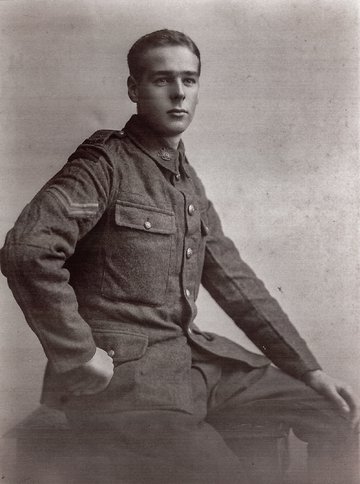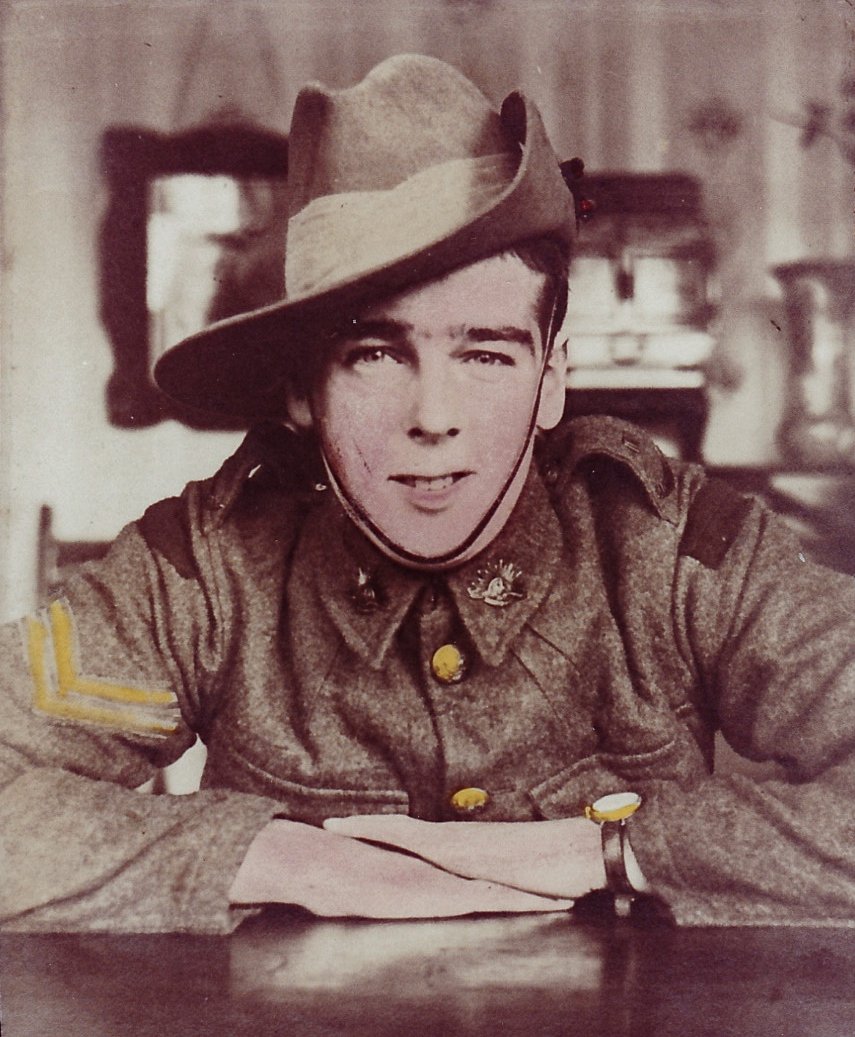John Marchmont CAMPBELL
Eyes grey, Hair fair, Complexion fair
Jack Marchmont Campbell - a beloved brother, never forgotten
With gratitude to Jack’s great niece, Mary Baker, and other family members for this story.
John Marchmont Campbell (known as “Jack”) was born in the Langside neighbourhood south of the river in Glasgow, Scotland in 1896. He was a twin and one of five children born in Glasgow to James and Janet (nee Winning) Campbell:
- Mary Winning Campbell - born 20 February 1894
- Winning Dick Hasskein Campbell - born 11 May 1896 (died age 4)
- Jack Marchmont Campbell - born 11 May 1896
- Phyllis Alix Campbell - born 9 November 1905
- Alexander MacDougall Campbell - born 28 May 1907
Their father, James, was born in Constantinople, Turkey, while Jack’s grandfather served as Chief Engineer on several Imperial Ottoman Arsenal ironclad ships and received the Order of the Medjidie from the Ottoman Sultan in 1874. James became a glass and china importer and married a waitress he met in a coffee shop. Jack’s paternal grandparents did not approve of his mother, Janet, though the extended family socialized together and was considered close.
Jack had a twin brother, Winning Dick Hasskein Campbell (known as “Dick”), who died at the age of four of an infectious disease (likely measles). Jack’s elder sister, Mary, doted on him, especially after Dick died. Their younger siblings, Phyllis and Alec, were born 9 and 11 years after Jack.

Top row (standing): Jane Campbell (aunt); John P Campbell (uncle); Alexander Campbell (uncle); Jane Campbell (cousin); Mary Campbell (aunt).
Centre (seated / kneeling): Mary Campbell (sister); Janet Campbell (mother); Jane Campbell (grandmother); James Campbell (father); Margaret Campbell (aunt).
Front: Jack Campbell; Alexander Campbell (brother); Phyllis Campbell (sister); Janet Campbell (cousin).
1910 to Australia
Like many of their generation, Jack’s parents had heard tales of adventure and prosperity to be had in Australia, and they decided to make the move in the hope of a more successful future. It is likely that James’ decision for the family to leave Scotland was influenced by the example of his grandparents’ overseas lives in Turkey and Japan as well as by his parents’ disapproval of his wife. The family arrived in Brisbane on the S.S. Ayrshire in November 1910 when Jack was 14 and they settled in North Sydney with James taking on travelling salesman work.
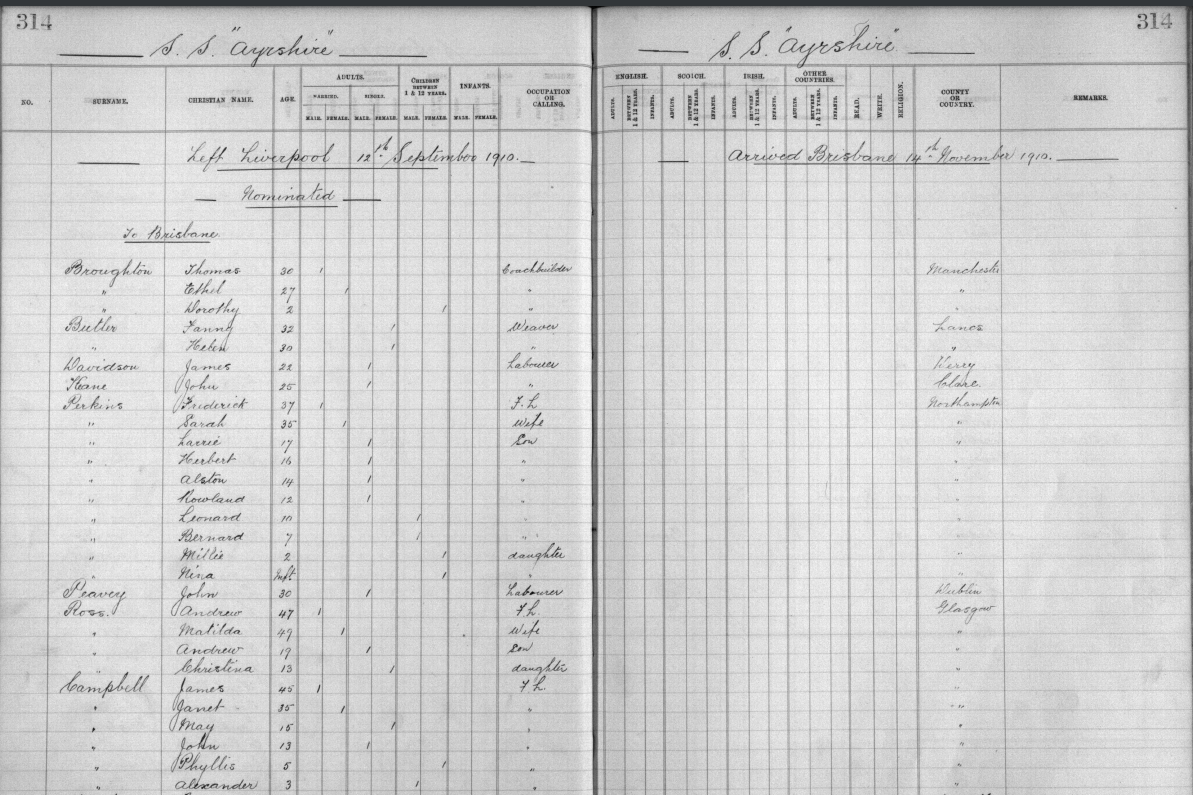
Jack at War – Gallipoli, Lone Pine and Egypt
When Britain declared war on Germany four years later (August 4, 1914), the world was watching. Voluntary enlistment for the Australian Imperial Force began soon after and Jack was one of the first to sign up, enlisting on August 17 adding a year to his age claiming to be 19 years though he was only 18. At enlistment, his weight was considered “slightly below standard” (130 pounds) but he was considered attentive and responsible, and he was quickly promoted to lance corporal in September 1914.
He left Sydney on October 18, 1914, and arrived in Alexandria, Egypt, on December 8, 1914. On April 5, 1915 he embarked on the troopship Derfflinger to participate in the Gallipoli landings at Anzac Cove (April 25, 1915). As a result of his performance under fire, he was promoted to corporal on May 7, 1915 – 4 days before his 19th birthday.
His family connection to Turkey was on his mind as he struggled in battle against Turkish troops with the other Anzac forces in a futile attempt to capture Constantinople. Jack fell ill and spent a week in a hospital on Lemnos with mumps in late July 1915, then returned to his unit where he participated in the battle of Lone Pine on the Gallipoli peninsula in August 1915. In September 1915, he suffered a serious case of influenza and was sent to England on the hospital ship Aquitania and then to the Fulham Military Hospital in London to recover.
He re-joined the 2nd Battalion in Alexandria in January 1916. In February 1916, he was promoted to Sergeant and sent to a command training course at Zeitoun, Egypt and to the newly formed 54th Battalion, a part of the "doubling" of the AIF. As recorded on the Australian War Memorial website, half of its recruits were Gallipoli veterans from the 2nd Battalion (like Jack), and the other half, fresh reinforcements from Australia. Reflecting the composition of the 2nd, the 54th was predominantly composed of men from New South Wales and it became part of the 14th Brigade of the 5th Australian Division.
To the Western Front
The call to join with the British Expeditionary Force on the Western Front came on 20 June 1916 and the 982 soldiers of the 54th left Egypt sailing to Marseilles via Malta on the H.T. Caledonian. After a 10-day trip, the troops disembarked in France and boarded trains for the three-day journey to Thiennes, 30 kilometres west of Fleurbaix. For Jack, the contrast between Gallipoli and the trenches of northern France must have been astounding.
According to the AIF Intelligence reports and AWM war diaries, by 2 July 1916 the Battalion was billeted in barns, stables and private houses for a week of training. This now included use of gas masks and exposure to the effects of the artillery shelling. It was hoped that these tests would “inspire the men with great confidence”.
On 10 July they were moved to Sailly sur la Lys and on the 11th, they were sent into the trenches in Fleurbaix. According to official records, the health and spirit of the troops was reported as good. After a few days’ exposure to the trenches, they moved back to billets in Bac-St-Maur.
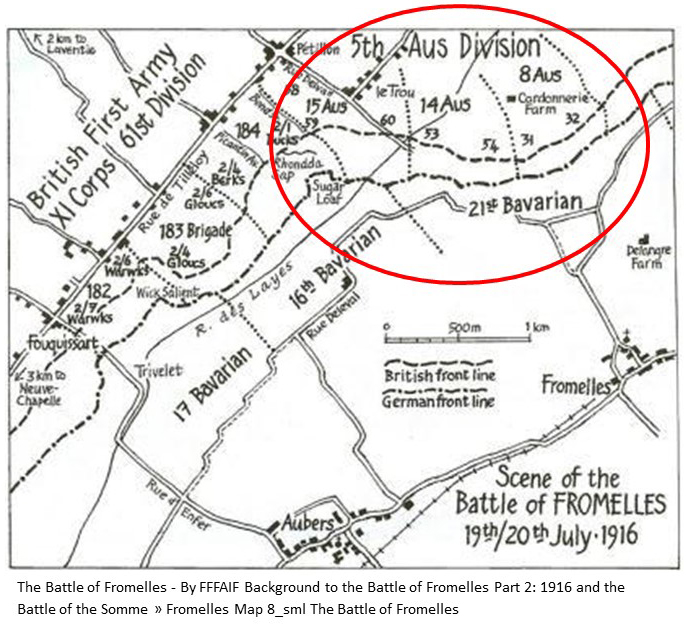
An attack was planned on the 17th, so they went back into the trenches. However, the attack was delayed due to the weather, and they were relieved at the front by the 53rd Battalion. The weather soon improved, and Jack returned to the front trenches by 2.00 pm on 19 July in readiness for the attack on the Germans.
The attack began at 5.50 pm. They were under fire from heavy artillery, machine guns and rifles, but were still able to advance rapidly and they occupied the German trenches by 6.00 pm. Some of the advance trenches were just water filled ditches.
Fighting and shelling continued throughout the night. With heavy losses and the German counterattacks, the Australians were eventually forced to retreat. The 54th were pulled all the way back to Bac-St-Maur by 7.30 am on the 20th.
In this very short period of time, about 250 of the 982 soldiers of the 54th that left Egypt were recorded as killed or missing, including Sergeant Jack Campbell.
Sergeant Jack Campbell – Killed in Action
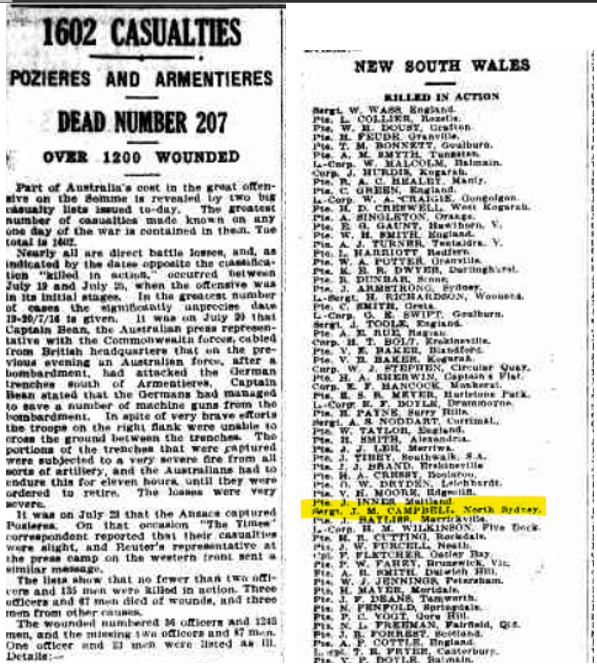
Jack’s AIF file shows that a London cable dated just two weeks after the Battle of Fromelles confirmed that Jack had been killed in action and advice for his father as next of kin was sent on 8 August 1916. No details as to the manner of Jack’s death appear on his AIF or Red Cross files but the cable being sent relatively soon after the battle indicates that some intelligence was available to confirm Jack’s death – possibly an eyewitness account from a survivor of the battle. It is hoped that a fellow soldier or superior officer had the opportunity to write to Jack’s family to give them some information, but we may never know.
Jack’s name appeared in the official casualty lists published in newspapers across Australia in mid-August 1916. He also later appeared on what is called the “German death list” that shows that the German authorities had his name recorded as one of those killed at Fromelles on 19 July 1916. They also passed on Jack’s identification disc for eventual return to his next of kin.
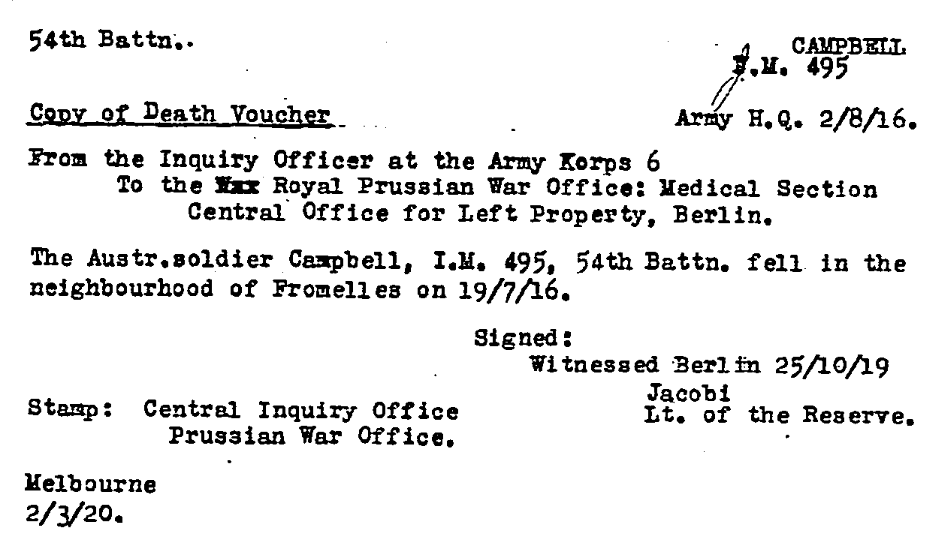
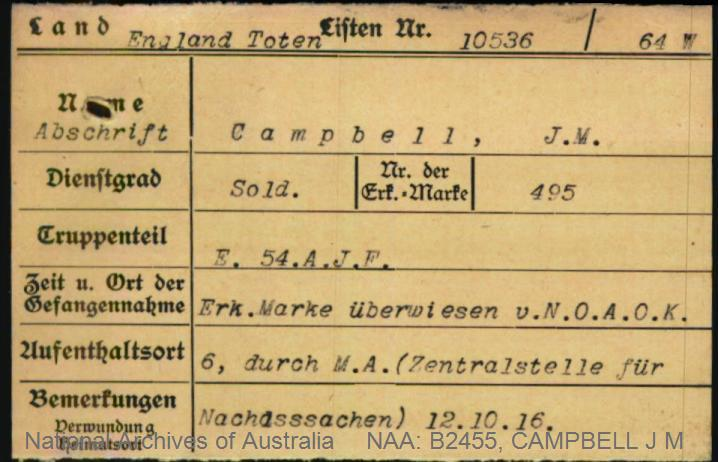
His father as his nominated next of kin eventually received Jack’s medals, identification disc and memorial plaque and scroll.
Sister Mary’s journey
The memory of “Uncle Jack” was kept alive by his elder sister, Mary Keast (nee Campbell) and his two younger siblings. Mary told her three children that Jack represented “the best” of young Australian men, and she compared all her suitors to him, finding most of them deficient in some way.
After the death of their parents, Mary inherited Jack’s medals and went on to communicate with public officials to obtain later medals and war records. Mary and Jack had been the closest of the siblings and she never got over his death.
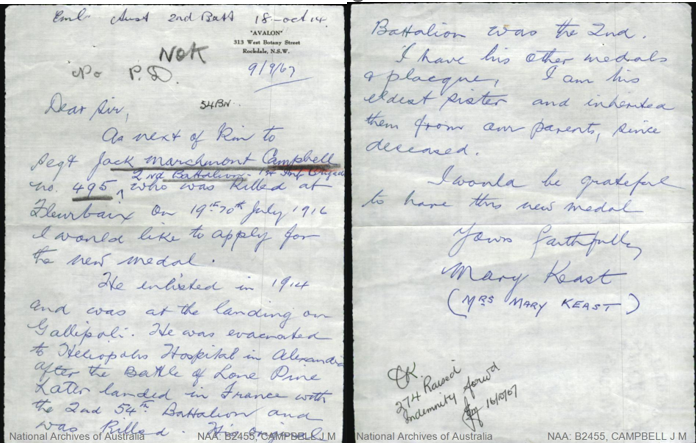
Family in WW2
Jack’s service and sacrifice influenced the rest of the family. Australia entered WWII in 1939 when Britain declared war on Germany though Australia was not at war with Japan until December 9, 1941.
Jack’s younger brother Alexander (known as Lec) responded to the call for volunteers to defend Australia in January 1942, on the same day the Japanese attacked New Guinea. He participated in the battles at Milne Bay, Papua, where his unit was cut off from supplies in September, 1942. As a result of a ruptured eardrum from his diving for air-lifted supplies, he went deaf in January 1943 and was sent to the 112th convalescent depot in Lae, north of Port Moresby, and then to the 102 AGH military hospital in Brisbane. He was sent to Buna, New Guinea in January 1944 where he caught dengue fever in March 1944. He was later sent to Jaquinot Bay to participate in “mopping up actions” in March of 1945, staying until December, 1945 when he was discharged.
Jack’s nephew, Allen Keast (eldest son of Jack’s sister Mary), signed up in October 1941 in Sydney but was judged to be temporarily unfit until October 1942. Sometime late in 1942, Allen Keast was sent to Milne Bay Papua where his Uncle Lec was also fighting Japanese troops. Allen was moved to Port Moresby Papua in May 1944 (where he re-enlisted in the field in August 1944) and participated in the landing at Jaquinot Bay New Guinea in November 1944, staying in the area until April 1945.
2011 News of the mass grave
In 2011, Janet Mary (Keast) Baker (daughter of Jack’s sister Mary) was reading a magazine in a hair salon in Lacey, Washington in the USA. She noticed a reference to mass graves found in France in a forested area, believed to hold the remains of British and Australian troops killed in 1916 - with 1335 Australians missing. The article stated that relatives would be sought to attempt to confirm the identity of the remains.
It also listed the names of several soldiers known to have been killed in the area and, to her astonishment, one name was that of her mother’s beloved brother, Jack Marchmont Campbell. She immediately contacted the toll-free number provided, and forwarded current family history information, a photograph of Jack, and a DNA sample. To her surprise, this resulted in the positive identification of Jack’s remains.
2014 Family to Fromelles Ceremony
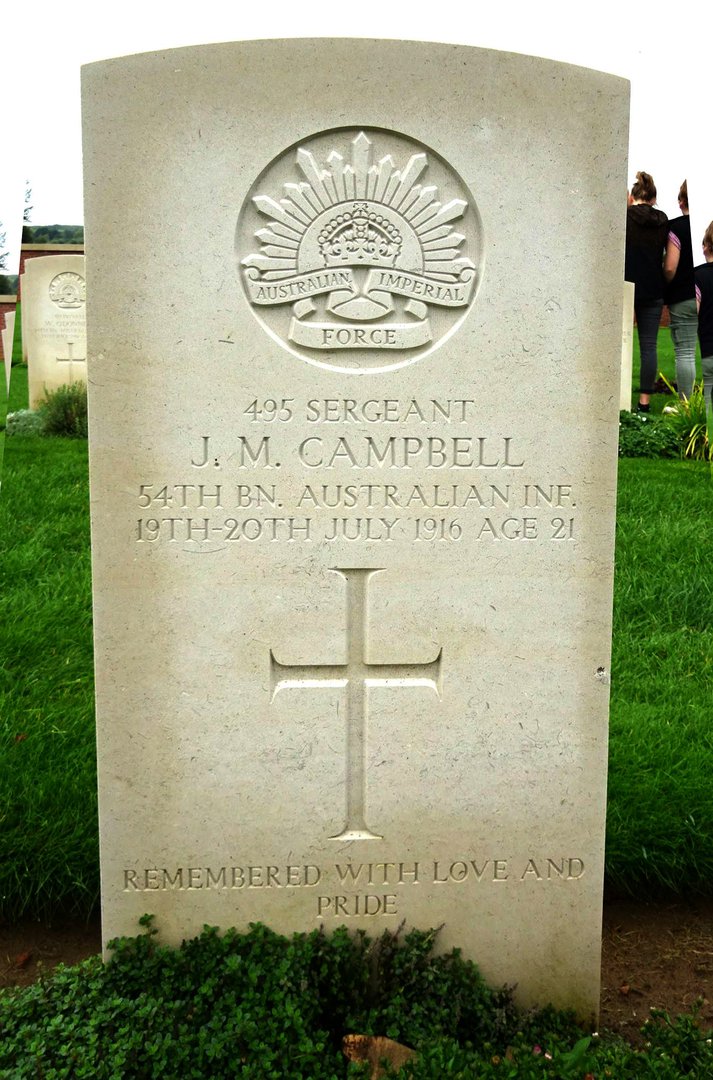
In July 2014, in a colourful, moving, and memorable ceremony in a new cemetery in Fromelles France, eight Campbell family members were present when Uncle Jack was honoured with a personalized gravestone, 98 years after his death. The event was attended by high-ranking military leaders from five nations with impressive pomp and ceremony. As each name was announced, two children from the local elementary school stepped forward to place red roses and a hand-printed card signed by the children on each grave marker. The cards, written in English in a childish hand, read “Thank you for your sacrifice, our country will never forget you!”

The bodies of many thousands of brave Australian servicemen who lost their lives in war remain undiscovered. To some, decisions to belatedly exhume, identify, and honour fallen heroes may seem unnecessary, but Jack’s family feel profound gratitude for all those who made it possible for family members to represent our grandparents and parents who were devastated by the death of a beloved son and brother at age 20, and to participate in the burial service recognizing his bravery and sacrifice.
Some people refer to the importance of closure, but a far greater benefit to the family in attendance (none of whom ever met the handsome, young Uncle Jack) is a renewed shared sense of family solidarity, of essential shared humanity, generational continuity, sorrow, love, pride, and patriotism.
As a family member commented, “Our beloved Uncle Jack found his way home to his family after all these years” and his headstone now bears the personal inscription, “Remembered with love and pride”.
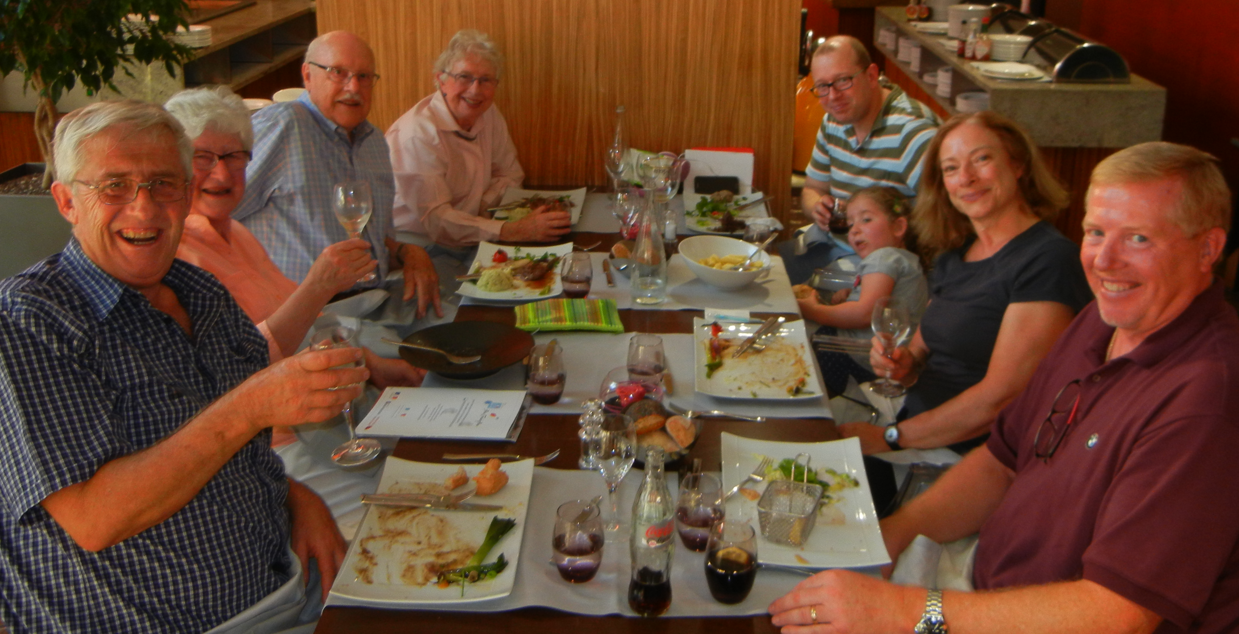
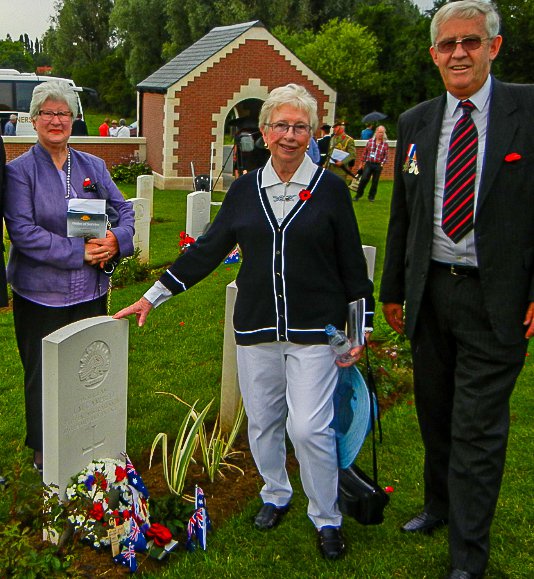
Footnote:
Janet and Syd Baker have both passed, and it is appropriate to particularly acknowledge Janet’s passion to support the research undertaken by the Fromelles Association for DNA donors, for all soldiers killed in action at Fromelles. A truly remarkable, warm lady, supported by a grand husband. RIP dear friends.
Royce (FAA)
Links to Official Records
The Fromelles Association would love to hear from you

Contacts
(Contact: carla@fromelles.info or geoffrey@fromelles.info).
(Contact: army.uwc@defence.gov.au or phone 1800 019 090).
Donations
If you are able, please contribute to the upkeep of this resource.
(Contact: bill@fromelles.info ).
